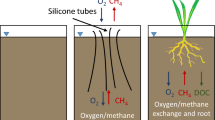Abstract
Ebullition of gas bubbles from the soil surface is, in some cases (e.g., in early growth stage of rice), one of the major pathways for methane transport from rice paddies to the atmosphere. However, the role of the gas phase (entrapped gas) in the paddy soil in plant-mediated methane transport, which is the major pathway for methane emission, has not been clarified. To clarify the effect of the gas phase below ground on the methane emission rate through rice plants, we partly exposed the root and stem base of hydroponically grown rice to a high concentration of methane gas at various gas pressures, and immersed the rest of the roots in a solution with a high methane concentration. The methane emission rate was measured from the top of the rice plant using a flow-through chamber method. The methane emission rate drastically increased with a small increase in gas pressure in the gas phase at the root and stem base zone, with about a 3 times larger emission rate being observed with 10 × 10-3 atm of extra pressure (corresponding to 10 cm of standing water in rice paddy) compared to no extra pressure. However, when alginate was applied to the stem near the base to prevent contact with the gas phase, the methane emission rate did not increase with increasing gas pressure. On the other hand, from observations in the rice paddy, it was found that the gas is entrapped near the surface (e.g., at a depth of 1 cm) and the gas entrapped in the soil would come into direct contact with a part of the stem near the base of the rice plant. Thus, the gas entrapped in the soil could enter into the rice body directly from the part of the stem near the base which is beneath the soil surface due to gas pressure in the gas phase resulting from the pressure exerted by the standing water. Hence, this mechanism involving the entrapped gas could play an important role in methane emission from rice paddy by affecting the plant-mediated methane transport as well as ebullition of gas bubbles.
Similar content being viewed by others
References
Cicerone R J and Shetter J D 1981 Sources of atmospheric methane: Measurements in rice paddies and a discussion. J. Geophys. Res. 86, 7203–7209.
Holzapfel-Pschorn A and Seiler W 1986 Methane emission during a cultivation period from an Italian rice paddy. J. Geophys. Res. 91D, 11803–11814.
Hosono T and Nouchi I 1997 The dependence of methane transport in rice plants on the root zone temperature. Plant Soil (In press).
Kludze H K, DeLaune R D and Patrick W H Jr 1993 Aerenchyma formation and methane and oxygen exchange in rice. Soil Sci. Soc. Am. J. 57, 386–391.
Lindau C W, Patrick W H Jr and De Laune R D 1993 Factors affecting methane production in flooded rice soils. In Agricultural Ecosystem Effects on Trace Gases and Global Climate Change. Eds. L A Harper et al. pp 157–165. ASA Special Publication no. 55. Am. Soc. Agron., Crop Sci. Soc. Am., Soil Sci. Soc. Am., Madison, WI.
Neue H U, Wassmann R, Lantin R S, Alberto M C and Aduna J B 1994 Ebullition of methane. IRRN 19–3, 36.
Nouchi I, Mariko S and Aoki K 1990 Mechanism of methane transport from the rhizosphere to the atmosphere through rice plants. Plant Physiol. 94, 59–66.
Nouchi I, Hosono T, Aoki K and Minami K 1994 Seasonal variation in methane flux from rice paddies associated with methane concentration in soil water, rice biomass and temperature, and its modeling. Plant Soil 161, 195–208.
Raskin I and Kende H 1985 Mechanism of aeration in rice. Science 228. 327–329.
Sass R L, Fisher F M, Turner F T and Jund M F 1991 Methane emission from rice fields as influenced by solar radiation, temperature, and straw incorporation. Global Biogeochem. Cycles 5, 335–350.
Schütz H, Schröder P and Rennenberg H 1991 Role of plants in regulating the methane flux to the atmosphere. In Trace Gas Emissions by Plants. Eds., T D Sharkey, E A Holland and H A Mooney. pp 29–63. Academic Press, San Diego.
Wang B 1995 Effect of rice cultivars on diel and seasonal methane emission. PhD-thesis, University of Philippines, Los Banos.
Wang M X and Shangguan X J 1995 Methane emission from rice fields in China. In Climate Change and Rice. Eds. S Peng et al. pp 69–79. Springer-Verlag, Berlin.
Yagi K and Minami K 1990 Effect of organic matter application on methane emission from some Japanese paddy fields. Soil Sci. Plant Nutr. 36, 599–610.
Yagi K, Tsuruta H, Kanda K and Minami K 1996 Effect of water management on methane emission from a Japanese rice paddy field: Automated methane monitoring. Global Biogeochem. Cycles 10, 255–267.
Author information
Authors and Affiliations
Rights and permissions
About this article
Cite this article
Hosono, T., Nouchi, I. Effect of gas pressure in the root and stem base zone on methane transport through rice bodies. Plant and Soil 195, 65–73 (1997). https://doi.org/10.1023/A:1004214829124
Issue Date:
DOI: https://doi.org/10.1023/A:1004214829124




